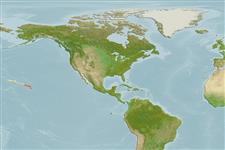Teleostei (teleosts) >
Callionymiformes (Dragonets) >
Callionymidae (Dragonets)
Etymology: Callionymus: Greek, kallion, comparative of kallos = beautiful + Greek, onyma = name; with a better name ; comptus: Named in reference to the many colorful markings of the male..
More on author: Randall.
Environment: milieu / climate zone / depth range / distribution range
Ecology
Marine; demersal; depth range 3 - 28 m (Ref. 33412). Tropical
Distribution
Countries | FAO areas | Ecosystems | Occurrences | Point map | Introductions | Faunafri
Eastern Central Pacific: Hawaii.
Size / Weight / Age
Maturity: Lm ? range ? - ? cm
Max length : 3.0 cm SL male/unsexed; (Ref. 33412)
Dorsal spines (total): 4; Dorsal soft rays (total): 8; Anal spines: 0; Anal soft rays: 7. Body of males with a narrow lateral yellow stripe edged in pale blue spots and overlaid by six orangish brown to orange red blotches; cheeks yellowish with a dusky orange red spot and irregular blue lines and spots; first dorsal fin yellowish anteriorly and blackish to black posteriorly. Females whitish with irregular brown blotches dorsally on head and body, and a midlateral row of six roundish brown spots; posterior two-thirds of first dorsal fin black.
Collected from sand bottoms near outer ocean reefs (Ref. 33412, 58302). Benthic (Ref. 58302).
Life cycle and mating behavior
Maturities | Reproduction | Spawnings | Egg(s) | Fecundities | Larvae
Randall, J.E., 1999. Review of the dragonets (Pisces: Callionymidae) of the Hawaiian Islands, with descriptions of two new species. Pac. Sci. 53(2):185-207. (Ref. 33412)
IUCN Red List Status (Ref. 130435)
Threat to humans
Harmless
Human uses
Tools
Special reports
Download XML
Internet sources
Estimates based on models
Phylogenetic diversity index (Ref.
82804): PD
50 = 0.5000 [Uniqueness, from 0.5 = low to 2.0 = high].
Bayesian length-weight: a=0.00912 (0.00408 - 0.02036), b=2.77 (2.59 - 2.95), in cm total length, based on LWR estimates for this Genus-body shape (Ref.
93245).
Trophic level (Ref.
69278): 3.1 ±0.4 se; based on size and trophs of closest relatives
Resilience (Ref.
120179): High, minimum population doubling time less than 15 months (Preliminary K or Fecundity.).
Fishing Vulnerability (Ref.
59153): Low vulnerability (10 of 100).
